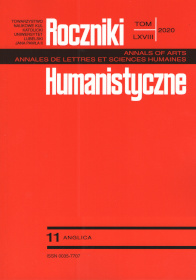Foreign-Space Dramatization in Graham Greene’s The Power and the Glory: Revisiting Greeneland
Abstrakt
Dramatyzacja obcej przestrzeni w powieści Moc i chwała Grahama Greene’a: Ponowna wizyta w Greeneland
Graham Greene często podróżował i akcja jego książek często ma miejsce w różnych zakątkach świata. Mimo to krytycy są zgodni, że w swych powieściach Greene stworzył a-topos – przestrzeń odzwierciedlającą rozwój tematów (czy to duchowych, czy politycznych) zajmujących autora, a nie konkretne rzeczywiste miejsce. Z czasem ów a-topos otrzymał nazwę Greeneland. Niniejszy artykuł stawia tezę, że krytycy, skupiając się na głównych motywach w twórczości Greene’a, ignorują fakt, że dokładna analiza świata przedstawionego podważa powszechnie panujące przekonanie, jakoby Greene wykreował w swojej twórczości przestrzeń mentalną, nie-miejsce. W celu dowiedzenia postawionej tezy, artykuł analizuje reprezentację przestrzeni i społeczeństwa w Mocy i chwale (1940), powieści, której akcja toczy się podczas religijnych prześladowań w Meksyku w latach dwudziestych dwudziestego wieku. Porównuję utwór Greene’a z powieścią Pedro Páramo Juana Rulfo (1955), gdyż powieść ta opisuje ten sam okres, a krajobrazy w niej opisane przypominają te z powieści Greene’a. Tym samym artykuł proponuje redefinicję idei Greeneland.
Bibliografia
Bosco, Mark. Graham Greene’s Catholic Imagination. Oxford UP, 2005.
Brotherson, Gordon. “Provincia de almas muertas.” Fell, pp. 808–13.
Diephouse, Daniel. “The Allusiveness of Space in Graham Greene’s Novels.”
Perceptions of Religious Faith in the Work of Graham Greene, edited by Thomas Hill, Peter Lang, 2002.
Duffy, Charles F. “Ireland and Greeneland: The Irish in the Writings of Graham Greene.” Éire Ireland, vol. 30, no. 3, 1995, pp. 14–26.
Fell, Claude, editor. Juan Rulfo: Toda la obra. Critical Edition, Consejo Superior de Investigaciones Científicas, 1992.
Franklin, Ruth. “God in the Details. Graham Greene’s religious realism.” New Yorker, 4 Oct. 2004, www.newyorker.com/magazine/2004/10/04/god-in-the-details. Accessed 10 May 10, 2020.
Escalante, Evodio. “Texto histórico y texto social en la obra de Rulfo.” Fell, pp. 561–81.
Greene, Graham. The Power and the Glory. Penguin Books, 1971.
Escalante, Evodio. Ways of Escape. Penguin, 1981.
González Boixo, José Carlos. “Lectura temática de la obra de Juan Rulfo.” Fell, pp. 549–60.
Lanning, Carmen Nadine. The Ambiente of Five Latin American Novels by Graham Greene. Michigan: UMI, 1986.
Link, Christopher A. “Bad Priest and the Valor of Pity. Shusaku Endo and Graham Greene on the Paradoxes of Christian Virtue.” Logos, vol. 4, no. 4, 2012, pp. 75–96.
Martín Salván, Paula. The Language of Ethics and Community in Graham Greene’s Fiction. Palgrave Macmillan, 2015.
McEwan, Neil. Graham Greene. Macmillan, 1988.
Mudford, Peter. Graham Greene. Northcode House, 1996.
Pearson, Sheryl. “‘Is There Anybody There?’ Graham Greene in Mexico.” Journal of Modern Literature, vol. 9, no. 2, 1982, pp. 277–90.
Pozas, Ricardo. Juan Pérez Jolote. México: Fondo de Cultura Económica, 1952.
Rodríguez, Manuel. “El México de Juan Rulfo.” Cuadernos cervantinos de la lengua española, vol. 2, 1955, pp. 88–93.
Rodríguez Monegal, Emir. “Relectura de Pedro Páramo.” Fell, pp. 744–51.
Rulfo, Juan. Pedro Páramo. Grove Press, 1994.
Russel Rourke, Brian. Mexicos of the Mind: British Writers of the 1930s in Mexico. Michigan: UMI, 1999.
Sinyard, Neil. Graham Greene. A Literary Life. Palgrave Macmillan, 2003.
Watts, Cedric. “Janiform Greene: The paradoxes and pleasures of ‘The Power and the Glory’.” Dangerous edges of Graham Greene: journeys with saints and sinners, edited by Dermot Gilvary and Darren J. N. Middleton, Continuum, 2011, pp. 97–112.
Watts, Cedric. “Darkest Greeneland: Brighton Rock.” Graham Greene Studies, vol. 1, 2017, pp. 133–44.
Copyright (c) 2020 Roczniki Humanistyczne

Utwór dostępny jest na licencji Creative Commons Uznanie autorstwa – Użycie niekomercyjne – Bez utworów zależnych 4.0 Międzynarodowe.





